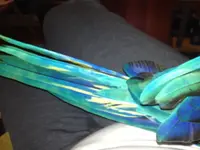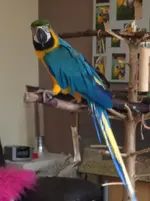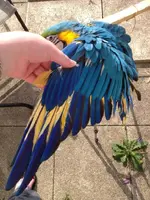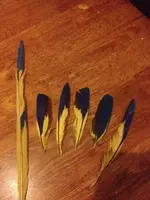lucy1
New member
- Nov 6, 2012
- 128
- 5
- Parrots
- Milo - my new baby B&G macaw! Rosie - Orange Wing Amazon & Rupert - Red Lored Amazon
I'm after any opinions or advice to help with my freaky fid please!
Milo is now 11 months old and is just finishing his first heavy moult. When I got him at 4 months old I noticed he had a small amount of yellow in his tail feathers

I thought this was quite nice and made him a bit different. But..., since his moult the yellow seems to be spreading His tail is now mostly yellow with blue tips
His tail is now mostly yellow with blue tips

and his wings now have a substantial amount of yellow in them - again yellow bases with blue ends on his primaries, secondaries and secondary coverts.

This on its own wouldn't be a problem (albeit a little weird), but there is an issue... The yellow bits are really weak and awful. Its not the lovely golden yellow on his front, it's a weak lemony colour, and seems to have a different structure to the blue. He is in good health and his blue feathers have a lovely glossy sheen, but the yellow bits are really weak and are deteriorating already.

And the WORST bit is that they are so weak that they actually break off at the yellow bits. When he crash lands or catches a wing on something when he flaps there's a good chance another feather will break off. The picture of his wing was taken several weeks ago, he has broken so many feathers now that he is effectively clipped without me having trimmed him! I guess I can see the positive side of a self-clipping parrot but it's heartbreaking watching them all break off

This was the result of a single play session!
So, does anyone know what this is? Any idea what is causing it and what we can do about it?
Milo is now 11 months old and is just finishing his first heavy moult. When I got him at 4 months old I noticed he had a small amount of yellow in his tail feathers

I thought this was quite nice and made him a bit different. But..., since his moult the yellow seems to be spreading

and his wings now have a substantial amount of yellow in them - again yellow bases with blue ends on his primaries, secondaries and secondary coverts.

This on its own wouldn't be a problem (albeit a little weird), but there is an issue... The yellow bits are really weak and awful. Its not the lovely golden yellow on his front, it's a weak lemony colour, and seems to have a different structure to the blue. He is in good health and his blue feathers have a lovely glossy sheen, but the yellow bits are really weak and are deteriorating already.

And the WORST bit is that they are so weak that they actually break off at the yellow bits. When he crash lands or catches a wing on something when he flaps there's a good chance another feather will break off. The picture of his wing was taken several weeks ago, he has broken so many feathers now that he is effectively clipped without me having trimmed him! I guess I can see the positive side of a self-clipping parrot but it's heartbreaking watching them all break off

This was the result of a single play session!
So, does anyone know what this is? Any idea what is causing it and what we can do about it?
